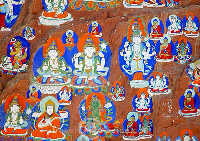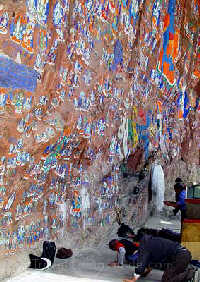|
Chakpori Hill
( 2005-10-27 )
 Rising up beside thePotala Palace, the Chakpori Hill (Yao Wang Shan, or literally the Hill of Medicine King) is 3,725 meters above sea level. Ascending the winding path to the top, one can get a panoramic view of the ancient city and its surrounding landscapes. Rising up beside thePotala Palace, the Chakpori Hill (Yao Wang Shan, or literally the Hill of Medicine King) is 3,725 meters above sea level. Ascending the winding path to the top, one can get a panoramic view of the ancient city and its surrounding landscapes.
The Chakpori Hill is also the ideal location for taking photographs of the Potala Palace. In the early morning of holidays or peak seasons, dense crowds of photographers and photography aficionados come here to shoot a rare view of the Potala Palace irradiated by the first rays of the sun.
The Chakpori Hill is very close to the Potala Palace, with a road in between that just cuts through the small mountain. In the middle of the road is a giant white pagoda, with an iron chain linking the two hills together.
It is said that Princess Wencheng of theTang Dynasty(618-907) often prayed on the hill facing the southeast, where her imperial home was. On the eastern cliff of the hill are the noted Zhalaupu Grottoes, which are extremely well preserved after a history of more than a thousand years. The grotto, in the shape of an unequal rectangle, is 27 square meters. There are 69 vivid and lifelike stone statues engraved on the rock, representing the soul of Tibetan stone inscription art. the soul of Tibetan stone inscription art.
On the southern cliff is a large cluster of rock carvings -- approximately over 5,000 cliff-side carvings --, which is the largest in number and most diversified in contents and style in Southwest China's Tibet Autonomous Region. A large number of them reflect images of the Thousand Buddhas. Others include images of Sakyamuni, Bodhisattva, Guardian of the Laws, and the Eleven-Faced Goddess of Mercy. Six-word Buddhist maxims are carved on the four sides of the images.
Near the hill are many families who engrave or decorate mani stones (stones that Tibetans decorate to show their religious piety). Every year, at the Sakadawa festival, crowds of pilgrims will come here to put mani stones by the hill, hence the piles and wall of mani.
It is said that once atemplewas erected on the top of the mountain. Within this temple was placed a sapphire figure of a certain Tibetan Medicine King. Legend has it that the King was the avatar incarnation of Sakyamuni, who was able to treat patients of any kind of diseases. During the period of the fifth Dalai Lama (1642-1682), lamas from all over the country were brought to this temple to systematically study and coordinate the knowledge of traditional Tibetan medicine. In the late 17th century, Desi Sangye Gyatso established the Tibetan Medical School on this hill in order to develop Tibetan medicine.
|

